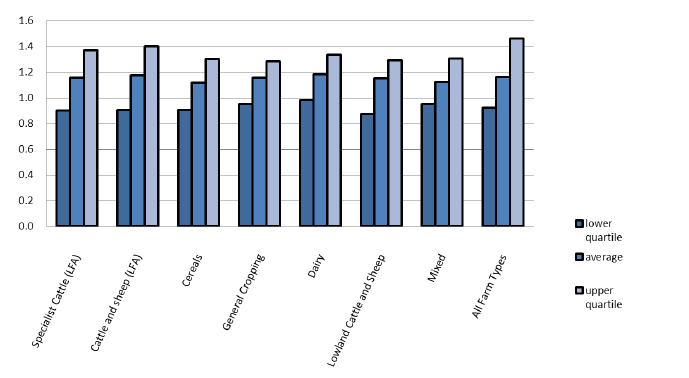Scottish farm business income: annual estimates 2013-2014
This publication contains farm business level estimates of average incomes for the accounting year 2013-14, relating to the 2013 crop year. For the most recent data, visit the Scottish farm business income (FBI) collection page below.
This document is part of a collection
4. Productivity (Output/ Input Ratio) (Table 2)
The output to input ratio can be viewed as a measure of productivity, that is, how much output can be produced per unit of input. Figure 8 shows the differences in the relationship between output value and input costs which contribute to the differences in FBI. The overall average output to input ratio is 1.16, meaning that for every £1 spent on inputs, Scottish farm businesses are generating £1.16 worth of outputs. The average for farms in the upper quartile (relatively high performers) is around £1.46, while for those in the lower quartile (relatively low performers) it is around £0.92; an average loss of £0.08 for every £1 spent. This translates into an average FBI of £105,000 for high performers, £31,000 for the sample average and a loss of £15,000 for low performers.
Table 2 shows that upper quartile specialist sheep (LFA) appear to be more efficient in 2013-14 at producing output than other farm types. This in part is due to a small number of specialist sheep (LFA) farms engaging in miscellaneous agricultural activities not related to sheep production, therefore this farm type is not displayed in Figure 8 but has been included in the calculation for average farms, but there appears to be greater variability for this farm type compared to, say, general cropping or dairy farms. As above, the quartiles here have been determined based on FBI, and not on output:input ratio.
Figure 8: Average output:input ratio by farm type and quartile
(lowest 25 per cent, average, upper 25 per cent)

It should be noted, however, that a higher output to input ratio does not necessarily lead to a higher FBI when comparing across farm type. FBI depends on both the ratio between and the absolute levels of outputs and inputs. For example, whereas the upper quartile output:input ratio of specialist sheep (LFA) farms, £2.91, was the highest of all farm types, the upper quartile of specialist sheep (LFA) farms, £204,000, was the second highest of all farm types. This was due to the relatively low absolute value of outputs and inputs.
Contact
Email: agric.stats@gov.scot
There is a problem
Thanks for your feedback